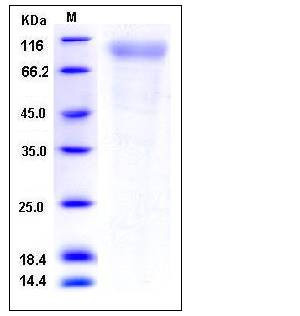Human CD180 / RP105 / LY64 Protein (His Tag)
LY64,Ly78,RP105
- 100ug (NPP3674) Please inquiry
| Catalog Number | P11370-H08H |
|---|---|
| Organism Species | Human |
| Host | Human Cells |
| Synonyms | LY64,Ly78,RP105 |
| Molecular Weight | The recombinant human CD180 consists of 614 amino acids and predictes a molecular mass of 69 kDa. In SDS-PAGE under reducing conditions, the apparent molecular mass of rhCD180 is approximately 90-100 kDa due to glycosylation. |
| predicted N | Trp 24 |
| SDS-PAGE |  |
| Purity | > 92 % as determined by SDS-PAGE |
| Protein Construction | A DNA sequence encoding the human CD180 (NP_005573.2) extracellular domain (Met 1-Gly 626) was fused with a polyhistidine tag at the C-terminus. |
| Bio-activity | Measured by its binding ability in a functional ELISA . Immobilized human CD180 at 2 μg/ml (100 μl/well) can bind biotinylated mouse MD-1 with a linear ranger of 3.125-25 μg/ml. |
| Research Area | Immunology |Innate Immunity |Monocytes/Macrophages |Monocyte Markers |
| Formulation | Lyophilized from sterile PBS, pH 7.4 1. Normally 5 % - 8 % trehalose, mannitol and 0.01% Tween80 are added as protectants before lyophilization. Specific concentrations are included in the hardcopy of COA. |
| Background | The cluster of differentiation (CD) system is commonly used as cell markers in immunophynotyping. Different kinds of cells in the immune system can be identified through the surface CD molecules which associating with the immune function of the cell. There are more than 320 CD unique clusters and subclusters have been identified. Some of the CD molecules serve as receptors or ligands important to the cell through initiating a signal cascade which then alter the behavior of the cell. Some CD proteins do not take part in cell signal process but have other functions such as cell adhesion. CD180, also known as RP105, is a B-cell surface molecule belonging to the family of pathogen receptors, Toll-like receptors (TLR). CD180 has an extracellular leucine-rich repeats and a short cytoplasmic tail. CD180 / RP105 interact with an extracellular molecule named MD1 and then together form the cell surface receptor complex RP105 / MD1 which induces B-cell activation in humans and mice, leading to proliferation and up-regulation of a costimulatory molecule, B7.2 / CD86. CD180 / RP105 also has a role in LPS response because B cells lacking RP105 show hyporesponsiveness to LPS. |
| Reference |
